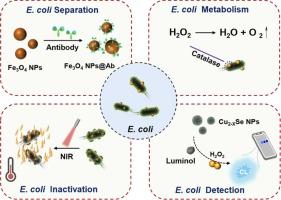A prolong glow-type chemiluminescence platform for sensitive detection and photothermal inactivation of Escherichia coli
IF 3.7
1区 化学
Q1 CHEMISTRY, ANALYTICAL
引用次数: 0
Abstract
Escherichia coli (E. coli) is a leading cause of hospital-acquired infections, especially in abdominal and urinary tract sites, posing serious risks for patients’ post-kidney transplantation. Rapid and precise detection of E. coli is critical to prevent complications such as bloodstream infections, urinary tract infections, and infectious shock. Here, we present a prolong glow-type chemiluminescence (CL)-based bacterial metabolism platform that achieves both sensitive detection and effective photothermal inactivation of E. coli based on multifunctional nanomaterials. This platform leverages the metabolic activity of E. coli to trigger a CL signal without the need for external excitation sources, facilitating low-cost and highly sensitive detection with a limit of detection as low as 1 CFU/mL. Fe3O4 NPs were functionalized with E. coil-specific antibodies, allowing for precise pathogen capture and magnetic separation, ensuring robust sample preparation. After detection, near-infrared (NIR) laser irradiation enabled the Cu2-XSe NPs to generate localized heat, effectively inactivating E. coli cells with an antibacterial efficiency of up to 99.18%. This multifunctional platform integrates rapid detection and sterilization, demonstrating significant potential for clinical applications in infection management, especially in post-transplant care.

一种用于大肠杆菌敏感检测和光热灭活的延长发光型化学发光平台
大肠杆菌(E. coli)是医院获得性感染的主要原因,特别是在腹部和尿路部位,对患者肾移植后的治疗构成严重风险。快速、精确地检测大肠杆菌对于预防血流感染、尿路感染和感染性休克等并发症至关重要。在这里,我们提出了一个基于延长发光型化学发光(CL)的细菌代谢平台,该平台实现了基于多功能纳米材料的大肠杆菌的敏感检测和有效光热失活。该平台利用大肠杆菌的代谢活性触发CL信号,无需外部激励源,检测成本低,灵敏度高,检出限低至1 CFU/mL。Fe3O4 NPs与E. coil特异性抗体功能化,允许精确的病原体捕获和磁分离,确保稳健的样品制备。检测后,近红外(NIR)激光照射使Cu2-XSeNPs产生局部热,有效灭活大肠杆菌细胞,抗菌效率高达99.18%。这个多功能平台集成了快速检测和灭菌,在感染管理,特别是移植后护理方面显示出巨大的临床应用潜力。
本文章由计算机程序翻译,如有差异,请以英文原文为准。
求助全文
约1分钟内获得全文
求助全文
来源期刊

Sensors and Actuators B: Chemical
工程技术-电化学
CiteScore
14.60
自引率
11.90%
发文量
1776
审稿时长
3.2 months
期刊介绍:
Sensors & Actuators, B: Chemical is an international journal focused on the research and development of chemical transducers. It covers chemical sensors and biosensors, chemical actuators, and analytical microsystems. The journal is interdisciplinary, aiming to publish original works showcasing substantial advancements beyond the current state of the art in these fields, with practical applicability to solving meaningful analytical problems. Review articles are accepted by invitation from an Editor of the journal.
 求助内容:
求助内容: 应助结果提醒方式:
应助结果提醒方式:


